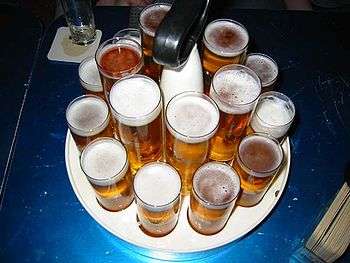Kölsch (beer)
| Kölsch | |
|---|---|
|
Kölsch served in the traditional 20-cL "Stange" glass | |
| Country of origin | Germany |
| Yeast type | Top-fermenting |
| Alcohol by volume | 4.4%–5.2% |
| Bitterness (IBU) | 20–30 |
| Original Gravity | 1.044–1.050 |
| Final Gravity | 1.007–1.011 |
| Malt percentage | usually 100% |
Kölsch (German pronunciation: [kœlʃ]) is a style of beer first brewed in Cologne, Germany. It is unusual because although it is warm fermented with ale yeast, it is then conditioned at cold temperatures like a lager.[1]. This hybridized brewing process is similar to some other central northern European beers such as Düsseldorf's altbier.
Kölsch has an original gravity between 11 and 16 degrees Plato (specific gravity of 1.044 to 1.065). In appearance, it is bright and clear with a straw-yellow hue.
Since 1997, the term "kölsch" has had a protected geographical indication (PGI) within the European Union, indicating a beer that is made within 50 km/30 miles of the city of Köln and brewed according to the Kölsch Konvention as defined by the members of the Köln Brewery Association
History


Bottom-fermented beer started to appear in the Cologne region in the early 17th century and its popularity threatened the business interest of the brewers of Cologne, who only produced top-fermented ales. In response, the town council of Cologne in 1603 forced young brewers to swear an oath "that you prepare your beer, as of old, from good malt, good cereals, and good hops, well-boiled, and that you pitch it with top-yeast, and by no means with bottom yeast."[2]:305 In 1676 and again in 1698, the council again tried to legislate against bottom-fermented beer by forbidding its sale within the city walls.[2]:305 However by 1750, Cologne brewers were competing against bottom-fermented beers by using a hybridized brewing process, first brewing their beer using top-fermenting yeast but then aging the beer in cold cellars like bottom-fermented beer.[2]:306
This type of beer was first called Kölsch in 1918 to describe the beer that had been brewed by the Sünner brewery since 1906, developed from the similar but cloudier variant Wieß (for "white" in the Kölsch dialect). By the start of World War II Cologne had more than forty breweries; only two were left by the end of the war.
In 1946, many of the breweries managed to re-establish themselves. In the 1940s and 1950s, Kölsch still could not match the sales of bottom-fermented beer, but in the 1960s the style began to rise in popularity in the Cologne beer market. From a production of only 50 million liters in 1960, Cologne's beer production peaked at 370 million liters in 1980. In the 21st century, price increases and changing drinking habits caused economic hardship for many of the traditional corner bars (Kölschkneipen) and smaller breweries, and by 2005 output had declined to 240 million liters.
In 1986, the brewers of Köln agreed upon the Kölsch Konvention, which set out the brewing process that had to be used, and restricted the use of kölsch to breweries that were within 50 km/30 mi of Köln. In 1997, Kölsch became a product with protected geographical indication (PGI), expanding this protection to the entire EU.[3] Currently thirteen breweries in and around Cologne meet this convention, anchored by Früh, Gaffel, Reissdorf and Kölner Verbund. Smaller brewers include Mühlen-Kölsch and Bischoff-Kölsch.
Exports of Kölsch to the United States, Russia, China and Brazil are increasing.[4] Exported Kölsch does not need to strictly comply with the Provisional German Beer Law, the current implementation of the Reinheitsgebot.
| Brewery | Established | Annual output in hectolitres |
|---|---|---|
| Heinrich Reissdorf | 1894 | 650,000 |
| Gaffel Becker & Co | 1908 | 500,000 |
| Cölner Hofbräu Früh | 1904 | 440,000 |
Serving Kölsch
In Cologne, Kölsch is traditionally served in a tall, thin, cylindrical 20-cL glass called a Stange ("spike" or "rod"). The server, called a Köbe, carries twelve Stangen in a Kranz, a circular tray resembling a crown or wreath.[5] Instead of waiting for the drinker to order a refill, the Köbe immediately replaces an empty Stange with a full one, marking a tick on the coaster under the Stange. If the drinker does not want another refill, he or she places the coaster on top of the empty Stange and pays for the number of beers marked on the coaster.[6]
Wieß
Wieß (transliterated as Wiess pronounced [viːs], for "white" in the Kölsch dialect) is a cloudy, unfiltered version of Kölsch.
Outside Europe
As noted above, Kölsch is a product which has a protected geographical indication (PGI) in Europe. This protection is not recognized outside the jurisdiction of the EU, and many small breweries outside Europe produce an ale aged at low temperatures and subsequently called "kolsch".
See also
- Knupp beer (Kölsches Knupp, Kölnisches Knupp, Kuletschbier), another type of beer of Colognian origin
- Cream ale
- Beer in Germany
References
- ↑ Ray Daniels, Designing Great Beers (Boulder, Colorado: Brewers Publications, 1996), 127-8 and 136-9.
- 1 2 3 Arnold, John P. (1911). The Origin and History of Beer and Brewing. Chicago: Alumni Association of the Wahl-Henius Institute of Fermentology.
- ↑ http://eur-lex.europa.eu/LexUriServ/LexUriServ.do?uri=OJ:L:1997:322:0033:0035:DE:PDF
- ↑ Bolsover, Catherine (1 October 2011). "Cologne's favorite beer, Kölsch, makes new friends abroad". Deutsche Welle. Retrieved 1 October 2011.
- ↑ "Kölsch Beer Glasses". Lee Valley Tools. 2018. Retrieved 2018-09-27.
- ↑ Porter, Erin (2018-02-06). "Beer of Cologne: Koelsch". TripSavvy. Retrieved 2018-09-27.
External links
- "Alles über das Kölner Bier". Michael Berger. Retrieved 2014-02-09. (in German)
- Kölsch-Konvention (in German)
- Website of the Deutscher Brauer-Bund e. V. (in German)
- Brauhaustouren in Köln (in German)
- Kölsch - German Beer Institute (in English)
- Frankfurter Allgemeine Article on the Work of a Köbes (in German)